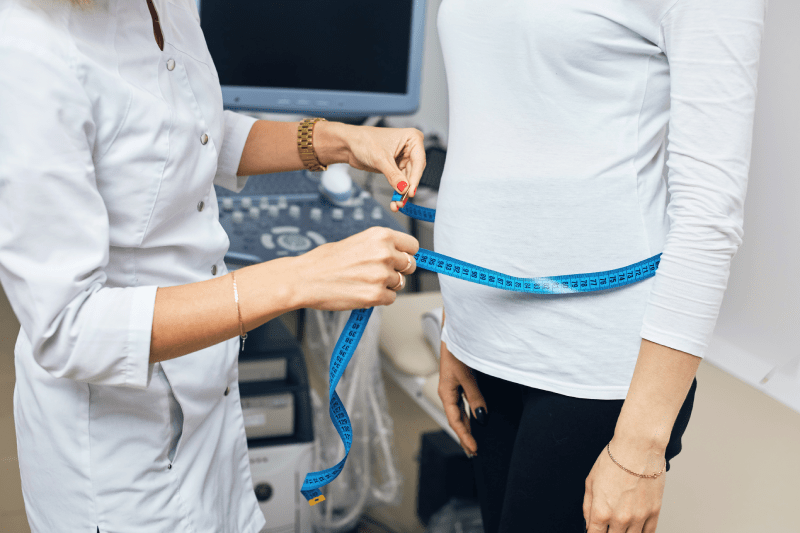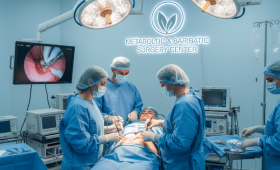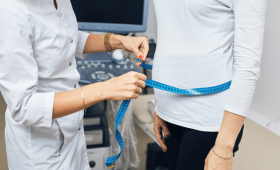What is the Average Cost of Obesity Surgery in Turkey?
The average costs for obesity surgery procedures (Sleeve Gastrectomy and Bypass) in Turkey are significantly lower compared to prices in Western countries. This pricing advantage stems from the lower general cost of living in Turkey and the attractive exchange rate difference for foreign patients. Prices vary according to the selected surgical method, the international accreditation of the hospital where the surgery will be performed, and the scope of the package services offered (accommodation, transfers, interpreter services). To get a precise cost estimate and a personalized quote, sharing your detailed medical history and contacting Cure Holiday will be the most accurate step.
What is Included in the Weight Loss Surgery Package?
Comprehensive weight loss surgery packages are designed to facilitate the patient’s entire journey, from arrival in Turkey to discharge. These packages cover not only the surgical procedure and anesthesia fees but also all compulsory blood and radiology tests required before the operation, accommodation costs during the hospital stay (usually 3 nights), initial post-operative medications and vitamin supplements, necessary consultations, and dietitian support. Furthermore, comfortable transfer services between the airport and the hospital are also a standard part of the package, ensuring a smooth process.
Why is Turkey Preferred for Obesity Surgeries?
Turkey owes its status as the primary choice for obesity surgery to its ability to combine high quality standards with economic costs. Most Turkish hospitals are equipped with state-of-the-art technology and possess international quality accreditations (such as JCI). Surgeons have gained worldwide experience due to high demand and the number of operations performed. The most significant factor is the exchange rate advantage (Euro, Dollar, or Sterling against the Turkish Lira), allowing foreign patients to receive high-quality service at much more affordable prices. This situation creates a substantial financial advantage for patients.
What is the Ideal Body Mass Index (BMI) for Surgery?
Body Mass Index (BMI) is generally the main criterion for being a candidate for obesity surgery. Ideal candidates are typically individuals with a BMI of 40 or higher. However, people with a BMI between 35 and 40 who have at least one serious chronic condition (comorbidity) related to obesity, such as Type 2 diabetes, high blood pressure, sleep apnea, or severe joint problems, are also considered eligible for surgery. Patients with Type 2 diabetes whose BMI is between 30-35 and whose condition cannot be controlled despite lifestyle changes may also be accepted after individual medical evaluation.
Is a Special Liver Diet Required Before Surgery?
Prior to bariatric surgeries like Gastric Sleeve and Bypass, the vast majority of patients are required to follow a special protein-rich, low-calorie pre-operative diet. The primary goal of this diet is to make the surgery safer. It promotes rapid weight loss, which shrinks and softens the liver, giving the surgeon a better field of vision around the stomach and significantly reducing surgical risk. The duration and content of this diet can vary between 1 and 3 weeks, depending on the patient’s initial BMI and liver size.
What Kind of Evaluation Process is Applied Before Surgery?
The pre-operative evaluation process is multi-staged to ensure the reliability of the surgical decision. This process includes detailed laboratory tests, imaging such as ECG and chest X-rays, and examinations by cardiologists, internal medicine doctors, and anesthesiologists. Furthermore, psychologist and dietitian consultations are mandatory to determine whether the patient is prepared for the post-operative nutrition plan and psychological changes. This comprehensive screening guarantees that the patient is fully ready for surgery, both physically and mentally.
What are the Age Limits for Obesity Surgery?
The lower age limit for obesity surgery is generally accepted as 18 years, based on the completion of the individual’s growth and development. The upper age limit is flexible and depends not on a strict rule but on the patient’s overall health status, control of chronic diseases, and the acceptability of the anesthesia risk. Patients over 65 can also undergo surgery following approvals from cardiologists and internal medicine specialists and comprehensive testing. What matters most is the body’s biological health and recovery potential, rather than chronological age.
Must Smoking and Alcohol Be Quit Before Surgery?
The absolute cessation of smoking and alcohol before surgery is critically important. Surgeons require smoking to be stopped entirely at least 4 to 6 weeks before the operation, as smoking delays wound healing, increases the risk of infection, and raises anesthesia complications. Alcohol should also be avoided for a similar period due to its negative effects on the liver and anesthesia. Adhering to these restrictions is a fundamental requirement for maximizing surgical safety and ensuring a successful recovery process.
How is Post-Operative Follow-up and Dietitian Support Provided?
Post-operative follow-up and dietitian support are as important as the surgery itself and should be a lifelong process. Following your surgery in Turkey, regular remote follow-up appointments (video calls) are scheduled with your surgeon and dietitian through Cure Holiday. During these sessions, the patient’s weight loss progress is monitored, blood test results are reviewed, and vitamin and mineral supplements are adjusted. This system is vital for the patient to maintain the correct nutrition plan and for the early detection of possible complications.
What is the Minimum Length of Stay Required in Turkey?
To ensure a safe and controlled recovery period in Turkey after obesity surgery, the minimum length of stay is generally set at 7 to 10 days. This period allows you to spend the critical first recovery phase resting in a hotel after the 3 days spent in the hospital, complete important initial check-ups with your surgeon, and ensure sufficient wound healing. This supervised recovery period is crucial for the prompt management of any potential early complications and for the patient to receive full clearance for long-haul air travel.

Are Accommodation and Transfer Services Included in the Package?
The majority of obesity surgery packages prepared for international patients include accommodation and transfer services to make the patient’s experience in Turkey comfortable and stress-free. These services encompass VIP vehicle airport transfers, all transportation between the hospital and the hotel, and a specified period of stay at a high-standard hotel suitable for your post-operative recovery. This logistical support allows patients to focus entirely on their recovery without worrying about transportation or accommodation in a foreign city. All details are meticulously planned by Cure Holiday.
Is the Surgery Performed Using the Laparoscopic Method?
Yes, the vast majority of obesity surgery procedures in Turkey are performed using the modern laparoscopic method (keyhole surgery), which ensures patient comfort and rapid recovery. This technique involves making small incisions on the abdomen to insert surgical instruments, rather than a large single cut. The laparoscopic method is considered the gold standard because it results in less pain, less blood loss, a shorter hospital stay, and much smaller, more cosmetically acceptable scars.
Which Medications Cannot Be Used or Must Be Used with Caution After Surgery?
The use of some medications is strictly prohibited or must be done with great caution after weight loss surgery. Chief among these are non-steroidal anti-inflammatory drugs (NSAIDs) (such as ibuprofen, naproxen), which carry the risk of damaging the stomach staple line and triggering ulcer formation. Additionally, some controlled-release medication forms must be used carefully due to compromised absorption. All medications should be adjusted to forms that are easy to swallow and optimized for absorption (liquid, chewable, crushable) after the surgery.
How Important is Psychological Support After Surgery?
Psychological support after weight loss surgery is as important as the physical change, as the operation fundamentally alters the patient’s relationship with food and requires the management of “emotional eating” habits. Patients may experience difficulties during the post-operative period due to body image issues, social pressures, and changing appetite/emotional responses. Regular consultations with a psychologist help the patient adapt to this new lifestyle, manage emotional triggers, and maintain mental resilience for long-term success.
What Does the Lifelong Follow-up Program Include?
The lifelong follow-up program, which is the key to the success of obesity surgery, ensures that the patient maintains their health in the post-operative period. The program includes: Annual comprehensive blood tests to monitor vitamin and mineral levels, regular consultations with the surgeon and dietitian (more frequently in the first year), and nutrition and lifestyle counselling. This continuous follow-up aims to ensure long-term success by enabling the early detection and prompt intervention for potential nutritional deficiencies or weight regain.
How is Gastric Sleeve Surgery Performed?
Gastric Sleeve (Tüp Mide) surgery is a procedure that involves the permanent removal of approximately 75-80% of the stomach. The operation is performed using laparoscopic instruments through small incisions made in the abdominal area. The stomach is shaped into a banana or a narrow tube, and the removal of the excised portion (especially the fundus, where the hunger hormone ghrelin is produced) means the patient can physically eat less food and experiences a reduced feeling of appetite. This procedure is restrictive only; it does not alter the anatomy of the small intestines or the path of nutrient absorption.
How Does Sleeve Gastrectomy Affect the Hunger Hormone?
Sleeve gastrectomy significantly reduces the production of Ghrelin, the primary hunger hormone, due to the removal of a large part of the stomach (especially the fundus area). The decrease in Ghrelin levels causes the patient to naturally feel less hungry in the post-operative period and consequently consume fewer calories. This hormonal change demonstrates that Gastric Sleeve provides a metabolic effect controlling appetite, not just mechanical restriction, and plays a critical role in the success of rapid weight loss.
Is There a Risk of New Reflux Developing After Sleeve Gastrectomy?
After sleeve gastrectomy, the transformation of the stomach’s shape into a vertical tube can cause new reflux complaints to emerge or existing reflux to worsen in some patients. The fundamental reason for this is the change in pressure balance across the upper and lower parts of the stomach. Such reflux symptoms can generally be managed with medication. If the patient had severe reflux before the operation, surgeons might recommend malabsorptive procedures like Gastric Bypass, which are more effective in treating reflux.
Is Sleeve Gastrectomy a Reversible Procedure?
No, Gastric Sleeve (Tüp Mide) surgery is not a reversible procedure, as approximately 75-80% of the stomach is permanently removed and taken out of the body. Therefore, it is crucial for patients to fully understand the long-term consequences and necessities when making this decision. However, in the rare event of complications such as insufficient weight loss, excessive weight regain, or severe reflux, the remaining sleeve can be converted to another surgical procedure like Gastric Bypass (revision surgery).
Does Sleeve Gastrectomy Affect the Small Intestine?
Gastric Sleeve (Tüp Mide) surgery is a restrictive procedure that reduces the volume of the stomach; it does not directly alter the anatomical structure, length, or nutrient absorption path of the small intestines. This is the main difference from Gastric Bypass. However, the faster passage of food out of the stomach and the change in the release of intestinal hormones can indirectly affect intestinal function. This effect does not create a risk of severe malabsorption like in Bypass, but supplementation is still required.
Which Vitamin Supplements are More Important After Sleeve Gastrectomy?
Vitamin supplementation is mandatory after Sleeve Gastrectomy due to reduced food intake. Although the risk of deficiency is lower than in Bypass because the absorption pathway is unchanged, the most critical are Vitamin B12 (if not adequately obtained from meat and dairy), Vitamin D, and Calcium. Iron and folic acid supplements are also recommended. The dosage and type of these supplements should be determined based on the patient’s regular blood test results; this follow-up is lifelong.

How Much Does the Stomach Shrink After Sleeve Gastrectomy?
In Gastric Sleeve (Tüp Mide) surgery, approximately 75% to 80% of the stomach is permanently removed. The remaining stomach volume shrinks to the size of roughly a banana or a small water glass (approximately 100-150 ml). This means the stomach shrinks to about one-fifth or one-quarter of its original volume. This restrictive volume causes the patient to feel full quickly, even with very small amounts of food, forming the mechanical basis of weight loss. This degree of shrinkage facilitates portion control.
What is the Long-Term Nutrition Routine After Sleeve Gastrectomy?
The long-term nutrition routine after sleeve gastrectomy is focused on small portions, high protein, and low carbohydrate/sugar intake. The routine is fundamentally based on consuming protein (meat, fish, eggs, legumes) first at every meal. The rule of separating liquid intake (water) from meals (no liquids 30 minutes before or after food) must be maintained lifelong. Avoiding processed foods, high-calorie liquids, and sugary foods is vital for preventing weight regain and similar dumping syndrome situations.
What is the Revision Option if Sleeve Gastrectomy Fails?
In cases where Gastric Sleeve (Tüp Mide) surgery fails due to inadequate weight loss, weight regain, or severe reflux, the most common revision option is the conversion of the Sleeve Gastrectomy to a Gastric Bypass. This procedure is called “Sleeve to Bypass Revision.” Converting to Bypass aims to achieve stronger metabolic outcomes by creating both additional volume restriction and a powerful malabsorptive effect. This revision surgery can be more complex than the initial operation, and the surgeon’s experience is paramount.
Which Foods Should Be Avoided After Sleeve Gastrectomy?
Foods that should be avoided in the long term after Sleeve Gastrectomy are those that might strain the new structure of the stomach or lead to weight regain due to high-calorie content. Specifically, high-sugar beverages, alcohol, high-calorie liquids like ice cream, dry and tough pieces of meat (which can cause difficulty swallowing), fatty sauces, and highly processed junk foods should be minimized. Starchy foods like bread, rice, and pasta should also be consumed sparingly and cautiously, as they can create a “stuck” feeling in the stomach.
In Which Area is the Leakage Risk Higher in Sleeve Gastrectomy?
The risk of leakage (sızıntı) in Sleeve Gastrectomy is higher in the proximal (upper) region, near the esophagus, where the largest portion of the stomach is cut and stapled. This area is the tensest and most vascular part of the stomach. Experienced surgeons mitigate this risk by using special supportive materials (reinforcement) on the staple line during the operation and closely monitoring patients post-operatively. Leakage is life-threatening, requiring early diagnosis and emergency intervention.
Is There a Risk of Regrowth After Sleeve Gastrectomy?
Yes, after Sleeve Gastrectomy, there is a risk of some degree of enlargement (dilation) in the remaining stomach (the tubular stomach) if the patient consistently consumes large portions and strains it over the years. This enlargement is one of the most common causes of weight regain. The only way to prevent this is to strictly adhere to post-operative nutrition rules lifelong, reduce portion sizes, and eat in a way that prevents straining the stomach. In cases of enlargement, revision surgery or endoscopic treatments may be considered.
Is the Stomach Valve Touched During Sleeve Gastrectomy?
During Gastric Sleeve (Tüp Mide) surgery, the valves (sphincters) at the entrance and exit of the stomach are generally not directly touched, and their function is preserved. However, cutting and stretching the stomach during the operation changes the pressure balance, particularly on the lower valve (pylorus). Increased pressure on the upper valve (cardia) can, as mentioned above, increase the risk of reflux. Preserving the anatomical integrity of the valves makes the procedure more physiological.
What Are the Advantages and Disadvantages of Sleeve Gastrectomy?
The main advantages of Sleeve Gastrectomy are that the surgical technique is less complex than Bypass, it carries a lower risk of malabsorption because the small intestine’s structure is unaltered, and it has a shorter operating time. The disadvantages are that the surgery is irreversible, there is a risk of reflux worsening or emerging in some patients, and it does not provide as strong metabolic effects as Bypass. The patient’s diabetes status and history of reflux should be carefully considered when making the decision.
Which Chronic Diseases Improve the Fastest After Sleeve Gastrectomy?
Thanks to weight loss and hormonal changes after Sleeve Gastrectomy, certain chronic diseases related to obesity show very rapid improvement. The fastest and most dramatic improvement is generally observed in Type 2 Diabetes; many patients rapidly reduce or completely cease their need for insulin or oral antidiabetic medications after surgery. Furthermore, Sleep Apnea complaints and High Blood Pressure (Hypertension) also show significant improvement in the first months, proportional to the reduction in excess weight.
How is Gastric Bypass Surgery Performed and How Does It Differ from Gastric Sleeve?
Gastric Bypass surgery is a complex procedure that creates both a restrictive and a malabsorptive effect. It differs from Sleeve Gastrectomy because it not only involves reducing the stomach size but also reroutes the small intestine. A small pouch (approximately 30-50 ml volume) is created from the upper part of the stomach (restriction). Then, the small intestine is cut and connected to this small pouch, allowing food to bypass a significant portion of the small intestine (malabsorption). This anatomical change increases the feeling of satiety and reduces nutrient absorption.

Which Patients is Gastric Bypass Most Suitable For?
Gastric Bypass is considered the most suitable surgical method, especially for patients with very high BMI (45+), uncontrolled Type 2 Diabetes, or severe gastroesophageal reflux (GERD) complaints. Due to its powerful malabsorptive and hormonal effects, the likelihood of Type 2 Diabetes going into remission is higher than with Sleeve Gastrectomy. Additionally, because Bypass almost completely resolves reflux symptoms, it is often the first choice for patients with reflux problems.
How Does the Malabsorptive Effect of Gastric Bypass Work?
The malabsorptive effect of Gastric Bypass occurs when food bypasses the first segments of the small intestine (the duodenum and part of the jejunum) and reaches the lower segment directly. These initial segments are where essential nutrients like iron, calcium, and B12 are absorbed. Bypassing these areas reduces calorie and nutrient absorption and promotes weight loss. However, this necessitates that the patient takes high-dose and diverse vitamin supplements lifelong, as severe deficiencies can otherwise arise.
What is Dumping Syndrome After Gastric Bypass and How is it Managed?
“Dumping Syndrome” is a condition that can occur in some patients after Gastric Bypass. It is triggered by the rapid passage of sugary or fatty foods from the small stomach pouch into the small intestine. Symptoms include palpitations, sweating, diarrhea, nausea, and dizziness. Management is simple: it is strictly necessary to avoid sugary, highly processed foods and high-fat foods. Eating slowly, separating solids and liquids, and consuming small portions are the most effective ways to prevent this syndrome. Dumping also acts as a deterrent, encouraging patients to avoid unhealthy foods.
How Does Gastric Bypass Surgery Resolve Reflux Complaints?
Gastric Bypass is often the best treatment option for patients with severe reflux complaints. This is because the surgery creates two main mechanisms that prevent stomach acid from escaping back into the esophagus, which is the cause of reflux. Firstly, only a small amount of food fits into the newly created small stomach pouch. Secondly, because the food flow from the stomach is redirected to the lower parts of the small intestine, the likelihood of acid secretion escaping back into the esophagus is greatly reduced or completely eliminated.
Which Vitamin Supplements are Vital After Gastric Bypass?
Due to the malabsorptive effect of Gastric Bypass, much more comprehensive and lifelong supplementation is vital compared to Sleeve Gastrectomy. The nutrients whose absorption is most affected in the small intestine are: Vitamin B12 (often in injectable form), Iron (especially in women), Calcium, and Vitamin D. Zinc and Folic Acid are also important. Taking these supplements regularly and often in higher doses than standard prevents serious long-term complications like anemia and osteoporosis.
Does Gastric Bypass Surgery Increase the Risk of Stomach Ulcers?
After Gastric Bypass surgery, there is a risk of ulcer (marginal ulcer) development, particularly at the surgical connection point (anastomosis). This risk is increased in patients who continue to smoke after surgery, regularly use NSAIDs (painkillers), or have an H. Pylori infection. To manage this risk, surgeons usually prescribe stomach protective medications (PPIs) for a long period (sometimes lifelong) after the operation. Strictly avoiding smoking and NSAIDs is the most critical step in minimizing the risk of ulcers.
How Reversible is Gastric Bypass Surgery?
Gastric Bypass surgery is considered theoretically more reversible than Sleeve Gastrectomy, but this is rarely performed. During the Bypass procedure, the stomach is not removed; only a small pouch is created. Therefore, in critical situations like severe nutritional deficiencies or life-threatening rare complications, the old stomach and intestinal line can be surgically reconnected. However, this is also a complex revision surgery and is generally considered a last resort option.
What is the Size of the New Stomach Pouch Created in Gastric Bypass?
The new stomach pouch created from the upper part of the stomach in Gastric Bypass surgery is quite small. The volume of this pouch is usually around 30 to 50 millilitres, which is roughly the size of an egg. This extremely small volume causes the patient to feel fullness with just a few bites, forming the restrictive effect of the Bypass. The small size of the pouch facilitates the patient’s post-operative portion control and contributes to rapid weight loss.
Why is Gastric Bypass More Effective on Metabolic Diseases?
Gastric Bypass involves not only volume restriction but also an anatomical change that allows nutrients to reach the lower parts of the small intestine faster. This causes the early and powerful release of hormones from the intestines that provide a feeling of satiety and improve insulin secretion (like GLP-1). This hormonal and metabolic effect is critically important for the resolution of Type 2 Diabetes, which is why Bypass is known as a method that yields stronger and faster results than Sleeve Gastrectomy in the treatment of diabetes.
Does Tolerance to Alcohol Change After Gastric Bypass?
Yes, tolerance to alcohol changes significantly and permanently after Gastric Bypass surgery. Due to the reduced size of the stomach and the direct routing of alcohol to the small intestine, alcohol enters the bloodstream much faster and in higher concentrations. This can cause patients to become quickly intoxicated with much smaller amounts of alcohol and may increase the risk of alcohol dependence. Alcohol consumption after surgery should either be completely stopped or strictly limited, which is important for both liver health and the success of weight loss.
What is the Long-Term Complication Rate of Gastric Bypass?
Although Gastric Bypass offers stronger and more lasting weight loss than Sleeve Gastrectomy, the risk of long-term complications is also slightly higher due to the anatomical changes. Long-term complications include nutritional deficiencies (due to impaired absorption at the bypass site), marginal ulcers (at the surgical connection point), internal hernias (resulting from intestinal rearrangement), and Dumping Syndrome. Regular and lifelong medical follow-up and vitamin supplementation are the only ways to manage and prevent these long-term risks.
Why is Long-Term Follow-up After Gastric Bypass Critically Important?
Long-term follow-up after Gastric Bypass is vital for the patient’s health. Due to the malabsorptive effect, patients may experience permanent deficiencies in essential nutrients like Vitamin D, Calcium, B12, and Iron. Long-term follow-up enables these deficiencies to be monitored with annual blood tests, the adjustment of supplement doses, and the prevention of serious consequences (anemia, osteoporosis). Furthermore, problems like weight regain or potential ulcer development can be detected early and intervened upon promptly.
What Are the Advantages and Disadvantages of Gastric Bypass?
The biggest advantages of Gastric Bypass are that it provides the highest rate of Type 2 Diabetes remission, permanently resolves severe reflux, and generally results in higher excess weight loss than Sleeve Gastrectomy. The disadvantages include that it is surgically more complex and time-consuming, anatomically harder to reverse, carries a high risk of long-term nutritional deficiency, and poses a risk of ulcer development at the surgical connection site. Bypass is therefore recommended for patients with accompanying diseases that cannot be controlled with other methods.

In Which Cases is Roux-En-Y Gastric Bypass Preferred Over Other Bypass Types?
Roux-en-Y Gastric Bypass (RYGB) is the most commonly performed type of Bypass worldwide. It is generally the first-choice method for patients with Morbid Obesity (BMI 40+), uncontrolled Type 2 Diabetes, and severe reflux complaints. The main reasons for preferring it over other bypass types (such as Mini Gastric Bypass) are its proven efficacy in resolving reflux, better long-term tolerability, and lower risk of bile reflux compared to other bypass types. This makes it the most reliable method with the most established standard follow-up.
How Much Does the Stomach Shrink After Obesity Surgery?
The amount of stomach shrinkage after surgery depends on the chosen surgical method. In Gastric Sleeve, approximately 75% to 80% of the stomach is removed, leaving a residual volume of about 100-150 ml. In Gastric Bypass, the newly created stomach pouch is only 30 to 50 ml in volume, which represents a much greater reduction than the original volume. In both procedures, this restrictive volume allows the patient to feel full with very little food, enabling sustained weight loss.
Which Chronic Diseases Improve with Surgery?
Obesity surgery not only achieves weight loss but also leads to the improvement or remission of numerous chronic diseases (comorbidities) associated with obesity. The most dramatic results are generally observed in Type 2 Diabetes; many patients can stop taking medication shortly after surgery. Furthermore, conditions such as high blood pressure (hypertension), sleep apnea, high cholesterol, and some joint pains also show significant improvement in parallel with weight loss. These improvements fundamentally transform the patient’s overall health and quality of life.
Can Type 1 Diabetes Be Treated with Obesity Surgery?
Obesity surgery is incredibly effective in treating Type 2 Diabetes, which is closely related to obesity, and often results in complete remission. However, Type 1 Diabetes is an autoimmune disease characterized by the destruction of the body’s insulin-producing cells. Therefore, surgery cannot cure Type 1 Diabetes. Nevertheless, due to weight loss and improved metabolic health, Type 1 Diabetes patients may experience a reduction in insulin resistance and a significant decrease in insulin requirement, which facilitates blood sugar management.
How is Post-Operative Pain Management Performed?
Post-operative pain is less intense than in open surgery because the laparoscopic incisions are small, but it is present in the first 24-48 hours. During the hospital stay, pain is managed continuously with strong intravenous painkillers and pumps. In the post-discharge period, oral painkillers prescribed by the surgeon should be used regularly. Effective pain management encourages the patient to mobilize early, walk, and perform breathing exercises, which significantly accelerates the recovery process.
How is the Risk of Clotting (Thrombosis) Reduced After Surgery?
The risk of clotting (Deep Vein Thrombosis – DVT) is high in obesity surgery patients due to immobility and circulation problems related to obesity. This risk is minimized by measures applied before and after surgery. These measures include the regular administration of blood thinner injections during the hospital stay, the use of special stockings that support blood circulation in the legs, and encouraging the patient to walk as soon as possible. Early mobilization is the most effective method for reducing the risk of blood clots.
Which Nutritional Stages Are Followed During the Recovery Process?
Post-operative nutrition is a gradual process that must be strictly adhered to, allowing the stomach to heal and adapt to its new volume. Generally, 4 main phases are followed: Clear Liquids in the first week (water, sugar-free compote), Full Liquids in the second week (protein shakes, yogurt), Pureed Foods in the third and fourth weeks, and Soft Solid Foods beginning in the fifth week. Each stage is determined by the dietitian to check the stomach’s tolerance and minimize the risk of complications.
When Can Exercise and Sports Be Resumed?
Movement begins in the early stages of the recovery process; light walks to prevent blood clotting should be initiated slowly (with the surgeon’s approval) immediately after hospital discharge. However, challenging sports and exercises that strain the abdominal muscles, involve heavy lifting, intense cardio, or weight training should generally be delayed for 6 to 8 weeks. This waiting period is vital for the complete healing of internal stitches and incision sites. The decision to return to intense exercise should be made under the guidance of your doctor.
Which Risks Decrease During Pregnancy After Obesity Surgery?
Weight loss and metabolic improvement after obesity surgery significantly reduce pregnancy risks associated with obesity. These reduced risks include: gestational diabetes, high blood pressure (pre-eclampsia), large baby birth (macrosomia), and a decreased need for Caesarean section. Being pregnant at a healthy weight after surgery provides a much safer environment for both mother and baby, but vitamin supplements must be managed with double caution throughout the pregnancy.
How is Post-Operative Constipation Managed?
Constipation is a common problem in the early and later post-operative period due to reduced solid food and fibre intake, insufficient fluid consumption, or certain medications (painkillers). The most effective ways to manage constipation are: increasing daily water and sugar-free liquid intake, using fibre supplements or mild laxatives with doctor approval, and encouraging regular walking to stimulate bowel movements. Once the patient progresses to pureed and solid foods, the focus should slowly shift to fibre-rich foods.
What is the Goal for Long-Term Success of the Surgery?
The long-term success of obesity surgery is measured not only by the amount of weight lost but by the patient losing more than 50% of their Excess Weight and maintaining this loss for longer than 5 years. The most important goal is the remission of chronic diseases related to obesity (diabetes, hypertension) and the permanent improvement of the patient’s quality of life, mobility, and overall health status. Long-term success requires lifelong follow-up, vitamin supplementation, and adherence to a healthy lifestyle commitment.



